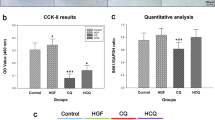Abstract
Antifibrotic effect of twelve diterpenes (1–12) from the 90% methanolic fraction of Biota orientalis leaves was evaluated employing HSC-T6 cells by assessing cell proliferation and morphological change. Among these diterpenes, totarol (8) and isopimara-8(14),15-dien-19-oic acid (9) dramatically reduced cell proliferation in dose-and time-dependent manner. Furthermore, treatment with these compounds resulted in the different pattern of morphological changes of HSC-T6 cells. Taken together, antiproliferative activity of diterpenes from B. orientalis might suggest therapeutic potentials against liver fibrosis.
Similar content being viewed by others
References
Arechabala, B., Coiffard, C., Rivalland, P., Coiffard, L. J. M., and de Roeck-Holtzhauer, Y., Comparison of cytotoxicity of various surfactants tested on normal human fibroblast cultures using the neutral red test, MTT assay and LDH release. J. Appl. Toxicol., 19, 163–165 (1999).
Bruno, M., Savona, G., Fernandez-Gadea, F., and Rodriguez, B., Diterpenoids from Salvia greggii. Phytochemistry, 25, 475–477 (1986).
Cai, X. F., Shen, G., Dat, N. T., Kang, O. H., Kim, J. A., Lee, Y. M., Lee, J. J., and Kim, Y. H., Inhibitory effect of TNF-alpha and IL-8 secretion by pimarane-type diterpenoids from Acanthopanax koreanum. Chem. Pharm. Bull., 51, 605–607 (2003).
Chen, A. and Zhang, L., The antioxidant (−)-epigallocatechin-3-gallate inhibits rat hepatic stellate cell proliferation in vitro by blocking the tyrosine phosphorylation and reducing the gene expression of platelet-derived growth factor-beta receptor. J. Biol. Chem., 278, 23381–23389 (2003).
Chung, B. S. and Shin, M. G., Dictionary of Korean Folk Medicine, Young Lim Sa, Seoul, pp. 107–112 (1990).
Evans, G.B., Furneaux, R.H., Gainsford, G.J., and Murphy, M.P., The synthesis and antibacterial activity of totarol derivatives. Part 2: Modifications at C-12 and O-13. Bioorg. Med. Chem., 8, 1653–1662 (2000).
Fang, J. M., Hsu, K. C., and Cheng, Y. S., Terpenoids from leaves of Calocedrus formosana. Phytochemistry, 28, 1173–1175 (1989).
Friedman, S. L., Liver fibrosis — from bench to beside. J. Hepatol., 38, S38–S53 (2003).
Haeuser, J., Lombard, R., Lederer, F., and Ourisson, G., Isolation and structure of a new diterpene, daniellic acid. Tetrahedron, 12, 205–214 (1961).
Han, B. H., Yang, H. O., Kang, Y. H., Suh, D. Y., Go, H. J., Song, W. J., Kim, Y. C., and Park, M. K., In vitro platelet-activating factor receptor binding inhibitory activity of pinusolide derivatives: a structure-activity study. J. Med. Chem., 41, 2626–2630 (1998).
Kang, H. S., Kim, Y. H., Lee, C. S., Lee, J. J., Choi, I., and Pyun, K. H., Suppression of interleukin-1 and tumor necrosis factor-alpha production by acanthoic acid, (−)-pimara-9(11),15-dien-19-oic acid, and it antifibrotic effects in vivo. Cell. Immunol., 170, 212–221 (1996).
Koo, K. A., Sung, S. H., and Kim, Y. C., A new neuroprotective pinusolide derivative from the leaves of Biota orientalis. Chem. Pharm. Bull., 50, 834–836 (2002).
Kosuge, T., Yokota, M., Sugiyama, K., Saito, M., Iwata, Y., Nakura, M., and Yamamoto, T., Studies on anticancer principles in Chinese medicines. II. Cytotoxic principles in Biota orientalis (L.) Endl. and Kaempferia galanga L. Chem. Pharm. Bull., 33, 5565–5567 (1985).
Li, D. and Friedman, S. L., Liver fibrogenesis and the role of hepatic stellate cells: new insights and prospects for therapy. J. Gastroenterol. Hepatol. 14, 618–633 (1999).
Micol, V., Mateo, C. R., Shapiro, S., Aranda, F. J., and Villalain, J., Effects of (+)-totarol, a diterpenoid antibacterial agent, on phospholipid model membranes. Biochim. Biophys. Acta, 1511, 281–290 (2001).
Mosmann, T. J., Rapid colorimetric assay for cellular growth and survival: application to proliferation and cytotoxicity assays. J. Immunol. Methods, 65, 55–63 (1983).
Sakata, R., Ueno, T., Nakamura, T., Sakamoto, M., Torimura, T., and Sata, M., Green tea polyphenol epigallocatechin-3-gallate inhibits platelet-derived growth factor-induced proliferation of human hepatic stellate cell line L190. J. Hepatol., 40, 52–59 (2004).
Sario, A. D., Bendia, E., Baroni, G. S., Ridolfi, F., Casini, A., Ceni, E., Saccomanno, S., Marzioni, M., Trozzi, L., Sterpetti, P., Taffetani, S., and Benedetti, A., Effect of pirfenidone on rat hepatic stellate cell proliferation and collagen production. J. Hepatol., 37, 584–591 (2002).
Sung, S. H., Koo, K. A., Lim, H. K., Lee, H. S., Cho, J. H., Kim, H. S., and Kim, Y. C., Diterpenes of Biota orientalis leaves. Kor. J. Pharmacogn., 29, 247–252 (1998).
Sy, L. K. and Brown, G. D., Abietane diterpenes from Illicium angustisepalum. J. Nat. Prod., 61, 907–912 (1998).
Vogel, S. R., Piantedosi, R., Frank, J., Lalazar, A., Rockey, D. C., Friedman, S. L., and Blaner, W. S., An immortalized rat liver stellate cell line (HSC-T6): a new cell model for the study of retinoid metabolism in vitro. J. Lipid. Res., 41, 882–893 (2000).
Wu, J. and Zern, M. A., Hepatic stellate cells: a target for the treatment of liver fibrosis. J. Gastroenterol., 35, 665–672 (2000).
Yang, H. O. and Han, B. H., Pinusolidic acid: a platelet-activating factor inhibitor from Biota orientalis. Planta Med., 64, 73–74 (1998).
Yang, H. O., Suh, D. Y., and Han, B. H., Isolation and characterization of platelet-activating factor receptor binding antagonists from Biota orientalis. Planta Med., 61, 37–40 (1995).
Zhu, J. X., Wang, Y., Kong, L. D., Yang, C., and Zang, X., Effects of Biota orientalis extract and its flavonoid constituents, quercetin and rutin on serum uric acid levels in oxonate-induced mice and xanthine dehydrogenase and xanthine oxidase activities in mouse liver. J. Ethnopharmacol., 93, 133–140 (2004).
Author information
Authors and Affiliations
Corresponding author
Additional information
Mi Kyeong Lee and Hyekyung Yang have contributed equally to this work.
Rights and permissions
About this article
Cite this article
Lee, M.K., Yang, H., Yoon, J.S. et al. Antifibrotic activity of diterpenes from Biota orientalis leaves on hepatic stellate cells. Arch. Pharm. Res. 31, 866–871 (2008). https://doi.org/10.1007/s12272-001-1239-9
Received:
Revised:
Accepted:
Published:
Issue Date:
DOI: https://doi.org/10.1007/s12272-001-1239-9




